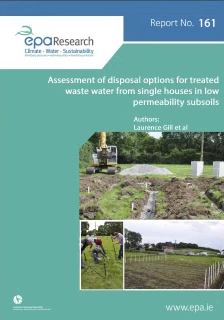Research 161 - Assessment of disposal options for treated waste water from single houses in low permeability subsoils
Authors: Laurence Gill, Donata Dubber, Vincent O’Flaherty, Mary Keegan, Kate Kilroy, Sean Curneen, Bruce Misstear, Paul Johnston, Francesco Pilla, Tim McCarthy, Nadeem Qazi and David Smyth
Summary: The potential impacts of incorrectly situated or poorly constructed domestic waste water treatment systems (DWWTSs) include the polution of either groundwater and/or surface water and places a risk on human health particularly via private wells.

The potential impacts of incorrectly situated or poorly constructed domestic wastewater treatment systems (DWWTSs) include the pollution of either groundwater and/or surface water and places a risk on human health particularly via private wells. It is estimated that the more than one third of the country may have inadequate site conditions for the installation of such on-site systems discharging to ground. This research has assessed the performance of existing soakaway systems in a range of different soil permeability settings and then evaluated a range of potential solutions for the treatment and discharge of on-site domestic wastewater into low- permeability soils.
Identifying Pressures
This research has evaluated the pollutant transport to groundwater and surface water from old existing soakaway systems in a range of different soil permeability settings. This showed that such soakaway systems in low permeability soils are likely to be causing shallow lateral flow of effluent into the nearest surface depression promoting a risk to surface water pollution. However, the natural attenuation ofbacteria and phosphorus in such lateral flow pathways does seem to be significant. This research has also shown the potential for the use of microbial source tracking techniques using human- specific Bacteriodales bacteria as well as other fingerprinting methods.A decision support tool has also been developed based upon geospatial modelling to identify existing DWWTSs on potentially problematic sites with low permeability soils, information which can feed into wider strategic planning debates.
Informing Policy
This research has demonstrated with field trials a range of systems that may be a solution for on-site wastewater treatment and disposal in low permeability soils, although changes in current policy and legislation would be required to facilitate their use. EPA staff will review the report and liaise with DECLG in relation to the relevant recommendations/findings highlighted by the authors and incorporate the findings into national guidelines as appropriateA decision support tool, also produced by this study, has been developed for strategic assessment at a Local Authority level to informpolicy. This has highlighted that surface water discharge may need to be reconsidered in areas where the discharge to ground is very problematic. It has also shown that the concept of clustered decentralised systems could target a significant proportion of potentially poor sites in low permeability areas and therefore lower the burden of monitoring associated with individual discharge consents.
Developing Solutions
The decision support tool also recommends a suite of suggested strategic solutions for systems in low permeability areas based on economic and sustainability criteria such as: extension of existing sewer networks; clustered decentralised systems with surface water discharge; and excavation of impermeable subsoil with discharge to bedrock. The use of water-saving devices in homes has also been identified as a method to increase the feasibility and sustainability of most effluent disposal options and should be considered where possible.
https://www.epa.ie/media/epa-2020/publications/research/161cover[1].png